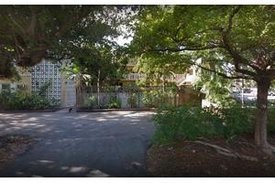Federation Gardens Of Davie
5701 SW 82nd Ave, Fort Lauderdale, FL 33328
"Federation Gardens Of Davie is a HUD Apartment. HUD residents usually pay 30% of their gross income for rent. The rent amount, less approved..."
READ MOREThere are 46 Independent Living communities in the Miami, FL area, with 8 in Miami.
Caring.com offers a free service to help families find senior care, and ...

46 Results
5701 SW 82nd Ave, Fort Lauderdale, FL 33328
"Federation Gardens Of Davie is a HUD Apartment. HUD residents usually pay 30% of their gross income for rent. The rent amount, less approved..."
READ MORE
1595 NE 145th St, North Miami, FL 33161
"To learn more about this provider’s license and review other available state reports, please visit: Florida Agency of Health Care Administra..."
READ MORE
1419 Meridian Ave, Miami Beach, FL 33140
"Casa Di Angelo Friendship Suites is located in Miami Beach, FL, where winter lows are 62 degrees and summer highs reach 88. The spacious fac..."
READ MORE
640 N Andrews Avenue, Fort Lauderdale, FL 33311
"Discover your new home at Village View in Fort Lauderdale, FL. This property is situated at 640 N Andrews Ave in the Flagler Heights area of..."
READ MORE1280 West 46th Street, Hialeah, FL 33012
"Hialeah Residence Apartments is located in the west section of Miami and is near banks, a post office, markets, pharmacies, a commercial ar..."
READ MORE
410 SE 16th Ct, Fort Lauderdale, FL 33316
"Upside is truly an exclusive opportunity to live independently on your own terms. We offer luxury living options with over 2,500+ apartments..."
READ MORECaring's Family Advisors are here to help you with questions about senior living and care options.
Independent Living
Patricia
4.0
Review of Irving Cypen Tower at Miami Jewish Health
Irving Cypen Tower at Miami Jewish Health had a lot of things that I could use, like the service of the doctors coming in and it's close to three different hospitals and also Palmer Eye Institute....
There are many other resources and activities for seniors in Miami. Use the table below to learn about the options available for older adults in the area.
| Resource | Phone number | Description |
|---|---|---|
| Miami-Dade Transit Special Pass Programs | (786) 469-5151 | Adults aged 65 and over who reside in Miami are eligible to ride Miami-Dade Transit for free with a Golden Passport transit pass. To apply for a pass, eligible residents can apply at the Miami-Dade Transit Golden Passport Office, which is located on the first floor of the Government Center at 111 NW. 1st Street in Miami. |
| Retired and Senior Volunteer Program | (786) 469-4851 | Miami residents aged 55 and over are eligible to participate in RSVP, a nationwide volunteer program for seniors. Through this program, participants can take part in volunteer opportunities, such as tutoring public school students or serving in local hospitals and senior centers. In exchange, volunteers receive insurance coverage, training, travel reimbursement and in some cases, meals. |
| Senior L.I.F.T Center | (305) 235-8855 | The Senior L.I.F.T Center (Living, Involvement, Fulfillment, Togetherness) provides classes, activities, road trips and cruises for Miami adults aged 50 and over. This nonprofit organization focuses on providing older adults with enriching experiences and social opportunities, giving members a place to meet new people and broaden their hobbies and interests. The center is open on weekdays from 9:30 a.m. to 3:30 p.m., and membership dues are paid on an annual basis. |
| Foster Grandparent Program | (786) 469-4844 | The city’s foster grandparent program is open to low-income residents aged 55 and over. Through this program, volunteers provide physical, emotional, mental and social support to special needs, at-risk children. In exchange for volunteer services, participants receive daily hot meals, transportation reimbursement, an hourly stipend and annual physicals. |
| The School of Continuing Education and Professional Development | (305) 237-8888 | Miami Dade College’s School of Continuing Education and Professional Development program provides adult education and personal enrichment courses to the community. It offers a wide array of areas of interest for older adults, including technology courses designed specifically for those aged 55 and over, child care training, decorating and design and recreational writing. |
Many seniors love how independent living communities reduce unwanted stress, hazards, and fatigue in their lives. Independent living communities take care of housekeeping, yard work and meals while still allowing residents personal space and the dignity of making their own choices. These communities usually provide seniors with an apartment that has a small kitchen, bathroom, living room, and one or more bedrooms. Those who want a small space may even find that some independent living communities offer studio-style apartments. Seniors can invite guests over and enjoy their rooms however they see fit.
Independent living communities often also include the following:
For a more detailed look at common amenities, check out our guide to independent living communities.
What Couples Should Know About Independent Living in Miami, FL
While Miami, Florida, is one of the most popular vacation destinations in the world, it’s also recognized as one of the best places to retire to in the state. Active retirees may be drawn to the city’s endless shopping opportunities, sporting events, art festivals, boat shows, auto racing events and a myriad of other activities that are showcased here. Those who enjoy traveling may also appreciate that Miami is home to a large international airport and the busiest cruise port in the world.
With 248 sunny days annually and year-round high temperatures ranging between 75 and 89 degrees, Miami offers plenty of opportunities for active seniors to take advantage of the local amenities. Summers tend to be very humid, which may be a consideration for some, but the region’s lack of snowfall may make it a good option for those who enjoy outdoor activities throughout the year.
Paying for Independent Living in Miami, FL
Per month, the average cost of independent living in Miami is $1,350, lower than the national average of $2,550.
The annual cost of living in an independent living community can range anywhere from $12,000-$42,000, depending mostly on the amenities, room type and cost of living in the area. In addition to using personal retirement income, annuities, long-term care insurance, or cashing out an existing life insurance policy, some seniors can use Social Security funds, Supplemental Security Income (SSI) payments granted due to disability or low-income or HUD-provided housing assistance such as vouchers. Another route many seniors choose to fund their independent living stay is renting out or selling their homes that they won’t need once they move or taking advantage of a reverse mortgage.
Our guide provides a more in-depth look at independent living costs and solutions for those who want to learn more.
How to Choose an Independent Living Community
When choosing an independent living community, it’s best to consider many factors, including the community’s proximity to loved ones and medical care, the state of repair that the facility appears to be in, the attitude and efficiency of the staff, the cost of both rent and services, the facility’s pet policy and more.
Comparing multiple communities can help seniors and their families figure out what they value most in an independent living community. During tours of these communities, staff members should be available to answer questions. To help with the touring and comparison process, we’ve included a checklist full of pertinent questions that anyone can download and print for themselves.
Transitioning to Independent Living
Independent living communities, rather than memory care or nursing homes, are often the first place seniors move to when they realize they need a lifestyle change. The necessity of letting some possessions go and the reality of leaving a home and neighborhood after possibly decades of residence there can make transitioning to an independent living community difficult. These communities are often friendly places, but being in a new environment still initially triggers feelings of loneliness in many seniors.
Having a strategy for dealing with the challenges of moving can make the transition to an independent living community a positive experience. We’ve created a downloadable step-by-step guide for tips to making this transition as smooth and enjoyable as possible.